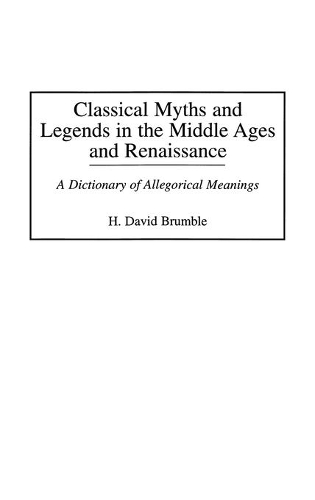
Classical Myths and Legends in the Middle Ages and Renaissance: A Dictionary of Allegorical Meanings
(Hardback)
Publishing Details
Classical Myths and Legends in the Middle Ages and Renaissance: A Dictionary of Allegorical Meanings
By (Author) H. David Brumble
Bloomsbury Publishing PLC
Greenwood Press
24th February 1998
United States
Classifications
Tertiary Education
Non Fiction
Folklore studies / Study of myth
Reference works
398.40902
Physical Properties
Hardback
480
Width 156mm, Height 235mm
907g
Description
Classical mythology had a vigorous life long after the fall of Rome. Throughout the Middle Ages and Renaissance, poets and playwrights such as Chaucer and Shakespeare drew upon classical myths to convey Christian beliefs allegorically. While readers of the Middle Ages and Renaissance could be expected to understand the allegorical significance of the ancient myths, contemporary readers are often unfamiliar with the veiled moralizations embedded in the mythological allusions of mediaeval and early modern authors. While numerous classical dictionaries identify the figures and tales of Greek and Roman mythology, this reference book explains the allegorical significance attached to the myths by Medieval and Renaissance authors. Thus the reader who encounters an allusion to Hercules in a 16th-century drama can quickly discover that Hercules was often interpreted as a personification of virtue during the Renaissance, and that the labours of Hercules could represent the triumph of morality over vice. Included are several hundred alphabetically arranged entries for the gods, goddesses, heroes, heroines, and places of classical myth and legend. Each entry includes a brief account of the classical myth, with reference to the Greek and Latin sources. The entry then discusses how Medieval and Renaissance commentators interpreted the myth allegorically, and how poets, dramatists and artists employed the allegorization of the myth in their creative works. Each entry includes a bibliography, and the volume concludes with appendices and an extensive bibliography of primary and secondary sources.
Reviews
.,."can be welcomed as a unique dictionary that can add dimension and depth to a body of literature - the works of writers "from the early Middle Ages to Milton" (xi) - that has become increasingly obscure....Consequently, each entry can be a fascinating journey through both semantic and intellectual history...[T]his is a unique book that should be in every library."-Reference & User Services Quarterly
"Only Brumble's dictionary focuses on gods' and heroes' allegorical significance in that part of the western canon of literature and art in which allegory was the lifeblood of artistic expression....[T]his will be the one and only source that quickly and conveniently explains matters such as how "Hercules' descent into Hades was a type of Christ's Harrowing of Hell" in Boccaccio and other's works. It will be a boon to students of the classical, medieval, and Renaissance world."-"Rettig on Reference" Gale Research, http: //www.gale.com
...can be welcomed as a unique dictionary that can add dimension and depth to a body of literature - the works of writers "from the early Middle Ages to Milton" (xi) - that has become increasingly obscure....Consequently, each entry can be a fascinating journey through both semantic and intellectual history...[T]his is a unique book that should be in every library.-Reference & User Services Quarterly
Brumble's well-researched work is highly recommended for libraries, schools, and anyone with an interest in literature and mythology.-ARBA
Only Brumble's dictionary focuses on gods' and heroes' allegorical significance in that part of the western canon of literature and art in which allegory was the lifeblood of artistic expression....[T]his will be the one and only source that quickly and conveniently explains matters such as how "Hercules' descent into Hades was a type of Christ's Harrowing of Hell" in Boccaccio and other's works. It will be a boon to students of the classical, medieval, and Renaissance world.-"Rettig on Reference" Gale Research, http: //www.gale.com
Recommended for academic libraries-Choice
Recommended for academic librariesChoice
..."can be welcomed as a unique dictionary that can add dimension and depth to a body of literature - the works of writers "from the early Middle Ages to Milton" (xi) - that has become increasingly obscure....Consequently, each entry can be a fascinating journey through both semantic and intellectual history...This is a unique book that should be in every library."-Reference & User Services Quarterly
"Brumble's well-researched work is highly recommended for libraries, schools, and anyone with an interest in literature and mythology."-ARBA
"Recommended for academic libraries"-Choice
Author Bio
H. DAVID BRUMBLE is Professor of English and Associate Dean for Undergraduate Studies at the University of Pittsburgh. /e
